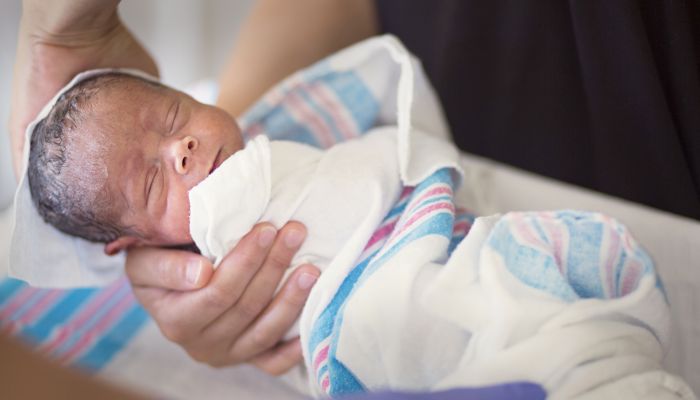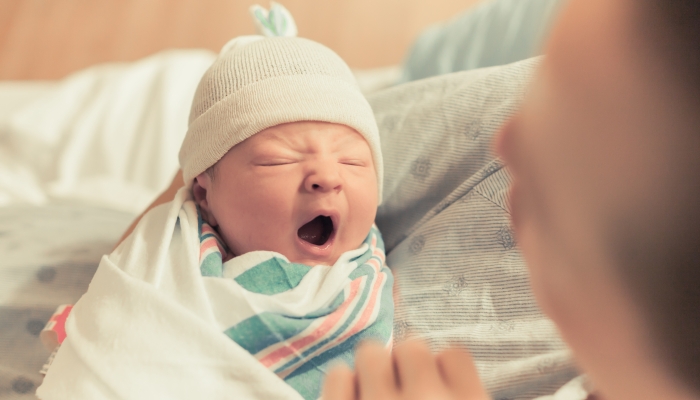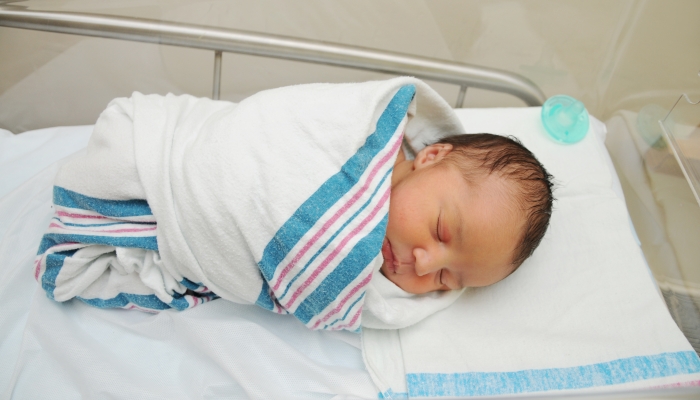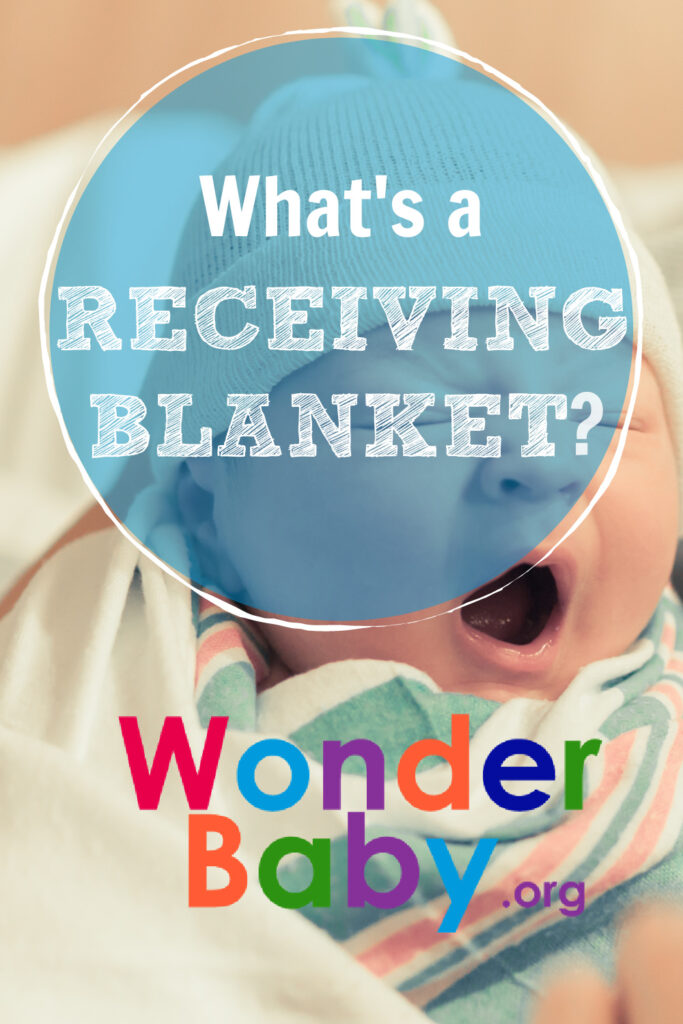What’s a Receiving Blanket? And Why You Need One

- The name receiving blanket originated from the custom of wrapping newborns before passing them off to mom to “receive.”
- Receiving blankets are typically made from soft fabrics such as flannel, cotton, muslin, or jersey knit.
- You can use receiving blankets for cleaning messes, swaddling your baby, covering surfaces, and more.
When looking for must-have baby products for your registry, you might be wondering, “What’s a receiving blanket?”
Receiving blankets are staple items in hospitals and nurseries alike. Almost every newborn announcement features a precious infant wrapped in a decorative receiving blanket. These popular blankets can be found on every box-store baby aisle. They often appear at baby showers by the dozen.
Their popularity may leave you with burning questions: What’s so important about baby receiving blankets, anyway? Is a baby receiving blanket the same as a swaddle blanket? Do you need to register for 5 or 15?
Don’t stress! A quick crash course on the basics of receiving blankets will clear up any confusion for new parents.
What’s a Receiving Blanket?
Receiving blankets refer to the blankets used to wrap newborns. Yes, this answer sounds too simple to be correct. The name originated from the custom of wrapping newborns before passing them off to mom to “receive.”
You might recognize the iconic hospital receiving blankets that first appeared in the mid-1900s. Today, those white blankets with pink and blue stripes continue to swaddle babies in the delivery room. They’re often regarded as the beloved first blanket of a newborn baby.
Nurses use those flannel receiving blankets to help regulate a baby’s body temperature. In the hospital infant crib, the swaddle blanket and knitted hat keep the baby warm while away from mom or dad.
Outside of the hospital, receiving blankets come in a variety of styles. You can find them in many patterns and colors. Some receiving blankets might be light and stretchy while others are thick and warm.
Receiving blankets are square or rectangular and are typically smaller than a child’s blanket. Their perfect size covers the newborn baby completely without leaving excess material.
What Can You Do With a Receiving Blanket?
A receiving blanket is useful for more than receiving your new baby despite its name. You can use receiving blankets for cleaning messes, swaddling your baby, covering surfaces, and more.
You can use a receiving blanket as a:
- Playmat for baby’s toys.
- Burp cloth for spit-up.
- Nursing cover for mom.
- Stroller cover for shade.
- Mat for tummy time.
- Swaddling blanket for baby.
- Keep-sake baby blanket.
- Decorative blanket for baby’s room.
- Cleaning wipe for spit up or messes.
- Photo backdrop after baby’s arrival.
- Blanket for peek-a-boo or other hiding games.
- Changing table cover for diaper changes in a public restroom.
- Cushion (when properly rolled up) for more protection in the car seat.
With so many uses from burp cloths to nursing covers, it’s easy to see why receiving blankets are such a popular registry item!

Using a Receiving Blanket Safely
It is important to know that loose blankets should never be left in your baby’s crib or sleeping area. Loose blankets can increase the risks for sudden infant death syndrome.
Be sure to use your receiving blanket to safely swaddle your baby rather than loosely cover them. You should swaddle them snug enough so they can fall asleep easily, but not so tight it causes pain.
A good way to see if the swaddle is too tight is to place two fingers between your baby’s chest and the swaddle. If your fingers don’t fit, loosen the swaddle until they do.
You also want to be sure your newborn baby doesn’t overheat. Be sure to use appropriate dress and swaddle blanket fabric for the temperature.
Choosing a Receiving Blanket
The type of receiving blanket that’s right for your baby will depend on your needs. The climate you live in and personal taste will be deciding factors as well.
Think about the average temperatures where you live. Will you want to swaddle your baby with a heavy or light fabric? Lighter fabrics like cotton and muslin are ideal for warmer climates. A thicker fabric like flannel is perfect for cooler temperatures. Consider how many you will need for summer versus winter where you live.
Deciding what jobs you’d like your receiving blankets to do will also help you decide. Thinner fabrics like muslin make excellent nursing covers. A more absorbent fabric like flannel makes a great burp cloth.
Receiving Blanket vs Swaddle vs Muslin: What’s the Difference?
You might see many names used for baby blankets. Muslin, receiving, and swaddling blankets are the most common baby blankets. They all have slight differences but common uses.
- Swaddle blankets are specifically designed to wrap with a snug fit around your newborn. You will find them in stretchy materials like jersey knit that allows for a tighter wrap.
(You might also notice swaddle wraps and wearable blankets in that category. These can only be used for swaddling your baby, as they aren’t a standard blanket. Swaddle wraps and wearable blankets come with special straps, zippers, or Velcro for a more secure fit.)
- Muslin blankets refer to any blanket made from muslin material. They are a bit larger than receiving blankets. This larger design creates room for easier swaddling. The breathable material allows for airflow so the baby doesn’t overheat.
- Receiving blankets include both swaddle blankets and muslin blankets. Both options allow you to snuggle, wrap, and hold your sweet newborn. The only difference is material and size.

FAQs
Why should I use a receiving blanket to swaddle my baby?
A 2005 study by Patricia Franco, et al found that swaddling babies increases infants’ sleep efficiency.
Babies often prefer sleeping in a swaddle because it reduces twitching and sudden movements that often wake them from sleep. These movements are part of the Moro reflex and are completely normal.
Many parents notice a major difference in the quality of baby’s sleep after they are swaddled. Swaddling an overstimulated baby often helps them to calm quickly.
How long do you use receiving blankets?
You can use a receiving blanket for years to come—long after you stop swaddling and the newborn days are over.
An old hospital receiving blanket will make a great cleaning cloth. A thin blanket like muslin is perfect for older children to use as a lovey. You can also use a receiving blanket to cover your toddler on a breezy stroller ride. When your child grows, you can even make a memory quilt out of old receiving blankets.
What is a receiving blanket made of?
Receiving blankets are typically made from soft fabrics such as flannel, cotton, muslin, or jersey knit.
How much does a receiving blanket cost?
Receiving blankets often come in a pack of 3 to 5 blankets and may cost anywhere from $10 to $40. The price depends on the material and brand you choose. A standard pack of 4 to 5 flannel swaddle blankets is an inexpensive choice, averaging around $10.
How many receiving blankets do I need?
Most new parents need around 3 to 6 receiving blankets. This is a good starting point if you are creating your registry and unsure of your needs.
If you know you’ll want your receiving blankets for many uses, consider registering for 5 to 8. You’ll want to have an extra blanket in your diaper bag and plenty to cycle through before the next load of laundry.

Related Posts

Parenting
7 Best ChatGPT Prompts for Busy Parents
Has life seemed extra busy lately? Use the best ChatGPT prompts to seek advice, save time, and focus on what’s important.

Behavior, Parenting
Help! I Have No Patience for My ADHD Child
Parenting a child with ADHD requires a lot of patience and understanding. If you’re looking for techniques for keeping your cool, have a look at our guide.

Development, Parenting
Distal and Proximal Parenting: Understanding the Difference
Understanding the history, differences, and strengths of proximal and distal parenting will help you decide what parenting approaches work best for your family.